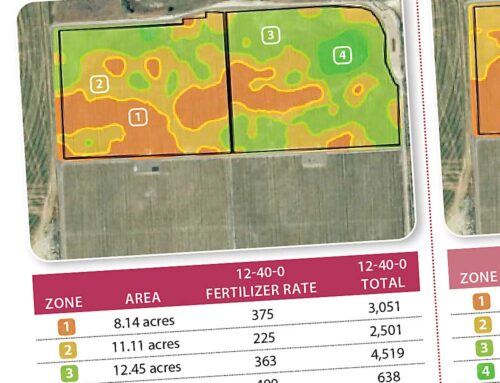
Craig O’Brien
A new wireless system that provides continuous monitoring of temperatures in orchards and vineyards has reduced stress, saved money, and lessened the chance of serious frost damage, Craig O’Brien of C & M Orchards, Yakima, Washington, reported at the Washington State Horticultural Association’s annual convention.
Washington State University’s Center for Precision Agricultural Systems has developed a radio-based system called the AgFrostNet that allows growers to have local on-farm temperature monitoring networks. A network consists of a radio/data logger with sensor at each of the monitoring points and a base radio in the orchard, usually situated at a high point within sight of the remote radios.
The base radio receives information from the remote radios at intervals and rebroadcasts the data to a roamer unit attached to a personal computer that reads, stores, and displays information so the grower can monitor what’s happening. The user can set the reporting interval. Dr. Fran Pierce, director of the CPAS, said growers usually choose a one-minute interval so that they have real-time information.
Remote stations
Pierce has demonstrated that the same radio system can be used to switch auto-start wind machines on and off remotely. O’Brien has been running the AgFrostNet for two years. He started out with five remote frost-monitoring stations and now has 21, with a station near each wind machine. Most of the wind machines are still manual start, but a few, in the coldest locations, start automatically. The base radio wakes up the remote radios once a minute to retrieve information and then puts them back to sleep to conserve power.
The base radio then broadcasts the data back to his two roamer units, each consisting of a laptop computer, a radio/data logger, and the AgFrostNet software. The laptops can be used in the office or home during the day and moved at night to the bedroom to alert him of critical temperatures. Each station can be set to sound an alarm at a specific temperature, or one setting can be applied to all stations. Any station can be selected to display a graph of the temperatures over the last six to 24 hours. The old frost alarm systems generally monitor one station not too far from the home, O’Brien said. The grower, through experience, develops a feel for how cold a cold spot is in relation to the frost alarm temperature near the home.
For example, the grower may set the frost alarm at 36 degrees, knowing that at that point the temperature is probably nearer 32 degrees in a cold spot. Usually, the grower is right, but sometimes the grower is surprised when the temperature in the cold spot is actually warm, or has plummeted below 32°F and is heading to 28°F. “This can result in getting up when it’s not yet necessary or, sometimes, getting up too late,” O’Brien said.
Comfort
Comfort With the AgFrostNet system, all the critical spots can be watched from the comfort of the home. As a safeguard, if any station fails to report a temperature during a 12-minute period, an alarm will sound. “So, now that the real-time temperatures in all the critical places are monitored from the bedroom, believe me, sleep comes easier,” O’Brien told the conference. “As temperatures fall, the auto-start wind machines fire up, and the temperatures at those stations rise.
If it’s not yet time to start the water, keep sleeping.” When the alarm does sound, he takes his laptop from the bedroom to the pickup and plugs it into an inverter to supply power during the night. Once up and about, he is able to continue monitoring all the stations and start wind machines and heat as needed.
“Previously, I’ve driven nearly 60 miles during a long night of protection, continuously monitoring temperatures from my truck, never getting more than two miles from the farm,”
he recalled. “Typically, I think most of us will start a machine when we drive by and see that the temperature is getting close, when there are other areas to check and it may be 30 minutes or more before we return to that spot. Now, all station temperatures can be seen at once, watched a bit longer, and startup takes place as needed.”
Confident
Confident O’Brien said many times temperatures have fallen close to critical values, only to start an upward trend when a breeze picks up. When data from several stations can be viewed in graph form, he can feel confident that no action is needed. Sometimes, when wind machines have been running for a while, he notices that temperatures are rising across all the stations. He then shuts off the machines in the warmest locations and continues to monitor the stations.
The machines might be restarted later, or they stay off for the rest of the night. O’Brien saves fuel by not starting machines earlier than needed and shutting them off when not needed. On nights when the inversion is weak and wind machines and undertree water are insufficient, the AgFrostNet system will show the continued downward trend of temperatures, allowing the grower to assess when more heat should be started. Another benefit of the AgFrostNet system is that when a wind machine inadvertently shuts down, the system will show the falling temperature and if the fall is not noticed, the alarm will sound, he said.
“Over my years of frost protection, I’ve come across machines that have died, for whatever reason, and my first reaction is to run up and place my hand on the radiator to see how long it’s been off. It’s a panicky feeling. With this temperature monitoring system, we’re on top of such incidents and have more time to react.”
The system has allowed the farm’s personnel to be more rested, he added. “Previously, three of us would get up, start a number of irrigation pumps and wind machines in the cold spots, and then spend the rest of the night cruising, checking temperatures, starting additional machines, and, like the foreman said, ‘chasing each other around like rabbits.’” Now, the three still get up and start the water and a few wind machines. Then, one or two can go back to bed. The next night, they rotate. They are all getting more sleep during this critical time of year. Later, the history of a particular night can be reviewed on the computer, showing exactly what happened.
For a large operation, the system could be used as a command center, with one person monitoring and radioing instructions to people in the field, he said. Owners who are not actively involved in frost protection can review the previous night’s data and stay better informed. If the data were put on the Internet, growers could retrieve the information even when they’re away from the farm. A Web-based network would also allow large companies to track temperatures at various orchards remotely.






Leave A Comment